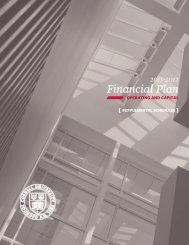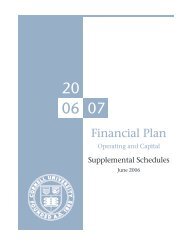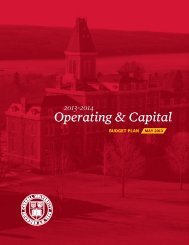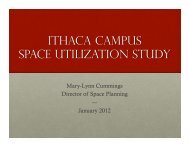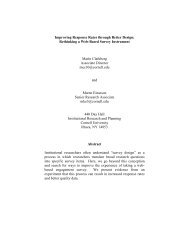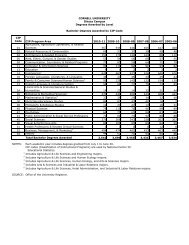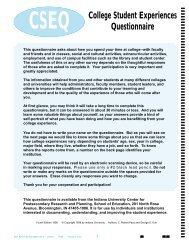Financial Plan - Cornell University Division of Budget & Planning
Financial Plan - Cornell University Division of Budget & Planning
Financial Plan - Cornell University Division of Budget & Planning
You also want an ePaper? Increase the reach of your titles
YUMPU automatically turns print PDFs into web optimized ePapers that Google loves.
Operating plan – highlightsIntroduction<strong>Cornell</strong>’s 2008-09 operating plan is illustrated belowand described beginning on page 6. Three primarysources fund this plan: user fees, government support,and private donations.• User fees are paid mainly by students for tuition,fees, room, board, and textbooks; by patients formedical services; by guests <strong>of</strong> the Statler Hotel;and by attendees <strong>of</strong> athletic events.• Government support includes state and federal appropriationsas well as almost all sponsored programs(grant and contract) activity.• Private donations take the form <strong>of</strong> operating plangifts as well as distributions (payouts) from endowmentsand other investments.The proportion <strong>of</strong> user fees in <strong>Cornell</strong>’s operating planhas grown over the past ten years, from 54 percent <strong>of</strong>the total to 59.3 percent. Donative support has alsogrown slightly, from 15.3 percent to 15.9 percent,while government support has declined as a percentage<strong>of</strong> the total, dropping from 30.6 percent to 24.7percent <strong>of</strong> all operating revenues due to a series <strong>of</strong> cutsin state appropriations for the contract colleges.Seventy percent <strong>of</strong> these resources are used to fund thedirect costs <strong>of</strong> the colleges, research centers, and otheracademic programs. The remaining 30 percent underwritesfinancial aid, student services, administrationand support, and the physical plant. Over the past tenyears, college and academic programs have declinedfrom 73 percent <strong>of</strong> the total to 70.1 percent whilefinancial aid has increased from 5.7 percent to 6.9percent. Student support has also declined, from 5.1percent to 4.1 percent, and physical plant costs havedropped from 8.3 percent to 6.5 percent. Administrativeand support costs have grown substantially, from7.9 percent <strong>of</strong> the total to 12.4 percent. A significantfactor in the administrative and support growth hasbeen the creation <strong>of</strong> the Weill <strong>Cornell</strong> Medical Collegein Qatar, which did not exist ten years ago. RemovingQatar from the analysis shows that administrative andsupport costs have grown, but at a lower rate, expandingfrom 7.9 percent to 9.9 percent <strong>of</strong> total costs overthis period. The growth in administrative and supportcosts unrelated to Qatar was due primarily to investmentsin administrative systems, fundraising, communications,investment management, and regulatorycompliance, among other factors. <strong>Cornell</strong> expects to<strong>of</strong>fset a significant portion <strong>of</strong> these costs with additionalrevenues derived from these activities.2008-09 <strong>University</strong>Operating <strong>Plan</strong>Student Services4.1%<strong>Financial</strong> Aid6.9%Administrative& Support12.4%Physical <strong>Plan</strong>t6.5%Clinical/HospitalServiceRevenues19.9%Investments10.7%Gifts5.2%State & FederalAppropriations6.4%Sales & Services<strong>of</strong> Enterprises5%RevenuesOther Sources10.6%SponsoredPrograms18.3%$2.921 billionTuition &Fees23.9%Expenditures$2.815 billionColleges &Academic Programs70.1%5



